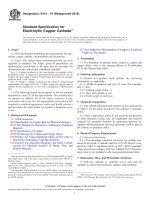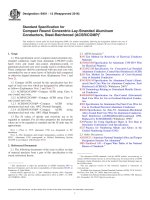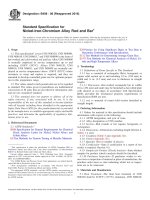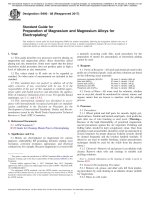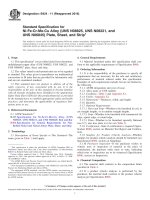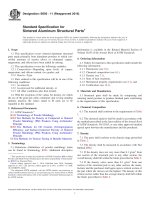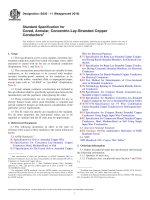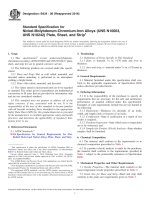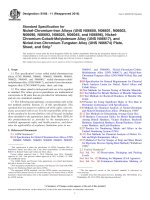Astm b 767 88 (2016)
Bạn đang xem bản rút gọn của tài liệu. Xem và tải ngay bản đầy đủ của tài liệu tại đây (114.81 KB, 6 trang )
Designation: B767 − 88 (Reapproved 2016)
Standard Guide for
Determining Mass Per Unit Area of Electrodeposited and
Related Coatings by Gravimetric and Other Chemical
Analysis Procedures1
This standard is issued under the fixed designation B767; the number immediately following the designation indicates the year of
original adoption or, in the case of revision, the year of last revision. A number in parentheses indicates the year of last reapproval. A
superscript epsilon (´) indicates an editorial change since the last revision or reapproval.
1. Scope
2. Referenced Documents
2.1 ASTM Standards:2
A90/A90M Test Method for Weight [Mass] of Coating on
Iron and Steel Articles with Zinc or Zinc-Alloy Coatings
A309 Test Method for Weight and Composition of Coating
on Terne Sheet by the Triple-Spot Test (Withdrawn 2015)3
A428/A428M Test Method for Weight [Mass] of Coating on
Aluminum-Coated Iron or Steel Articles
B137 Test Method for Measurement of Coating Mass Per
Unit Area on Anodically Coated Aluminum
B449 Specification for Chromates on Aluminum
2.2 British Standards Institution Documents:4
BS 729 Hot Dip Galvanized Coatings on Iron and Steel
Articles, Specification for
BS 1706 Electroplated Coatings of Cadmium and Zinc on
Iron and Steel, Specification for
BS 1872 Electroplated Coatings of Tin, Specification for
BS 3189 Phosphate Treatment of Iron and Steel, Specification for
BS 3382 Electroplated Coatings on Threaded Components,
Specification for
BS 3597 Electroplated Coatings of 65/35 Tin-Nickel Alloy,
Specification for
2.3 Government Standards:
2.3.1 DOD Standard:5
DOD-P-16232F Phosphate Coatings, Heavy, Manganese or
Zinc Base (for Ferrous Metals)
2.3.2 Federal Standards:6
FED-STD 151b Metals; Test Methods: Test 513.1 for Weight
of Coating on Hot Dip Tin Plate and Electrolytic Tin Plate
1.1 This guide outlines a general method for determining
the mass per unit area of electrodeposited, electroless,
mechanically-deposited, vacuum-deposited, anodicoxide, and
chemical conversion coatings by gravimetric and other chemical analysis procedures.
1.2 This guide determines the average mass per unit area
over a measured area.
1.3 The stripping methods cited are described in specifications or in the open literature or have been used routinely by at
least one laboratory.
1.4 The procedures outlined can be used for many coatingsubstrate combinations. They cannot be used where the coating
cannot be separated from the substrate by chemical or physical
means as would be the case if white brass were plated with
yellow brass.
1.5 In principle, these procedures can be used to measure
very thin coatings or to measure coatings over small areas, but
not thin coatings over small areas. The limits depend on the
required accuracy. For example, 2.5 mg/cm2 of coating might
require 2.5 mg of coating covering 1 cm2, but 0.1 mg/cm2 of
coating would require 25 cm2 to obtain 2.5 mg of coating.
1.6 The values stated in SI units are to be regarded as
standard. No other units of measurement are included in this
standard.
1.7 This standard does not purport to address all of the
safety concerns, if any, associated with its use. It is the
responsibility of the user of this standard to establish appropriate safety and health practices and determine the applicability of regulatory limitations prior to use.
2
For referenced ASTM standards, visit the ASTM website, www.astm.org, or
contact ASTM Customer Service at For Annual Book of ASTM
Standards volume information, refer to the standard’s Document Summary page on
the ASTM website.
3
The last approved version of this historical standard is referenced on
www.astm.org.
4
Available from British Standards Institute (BSI), 389 Chiswick High Rd.,
London W4 4AL, U.K.
5
Available from Standardization Documents Order Desk, DODSSP, Bldg. 4,
Section D, 700 Robbins Ave., Philadelphia, PA 19111-5098.
6
Available from U.S. Government Printing Office Superintendent of Documents,
732 N. Capitol St., NW, Mail Stop: SDE, Washington, DC 20401.
1
This guide is under the jurisdiction of ASTM Committee B08 on Metallic and
Inorganic Coatings and is the direct responsibility of Subcommittee B08.10 on Test
Methods.
Current edition approved Nov. 1, 2016. Published November 2016. Originally
approved in 1987. Last previous edition approved in 2010 as B767 – 88 (2010).
DOI: 10.1520/B0767-88R16.
Copyright © ASTM International, 100 Barr Harbor Drive, PO Box C700, West Conshohocken, PA 19428-2959. United States
1
B767 − 88 (2016)
6. Specimen Preparation
RR-T-51D Tableware and Flatware—Silverplated
2.3.3 Military Standard:5
MIL-M-45202C Magnesium Alloys, Anodic Treatment of
2.4 ISO Standards:7
ISO 2081 Metallic Coatings—Electroplated Coatings of
Zinc on Iron or Steel
ISO 2082 Metallic Coatings—Electroplated Coatings on
Cadmium on Iron or Steel
ISO 2093 Metallic Coatings—Electrodeposited Coatings of
Tin, Annex B
ISO 2106 Anodizing of Aluminum and its Alloys—
Determination of Mass Per Unit Area (Surface Density) of
Anodic Oxide Coatings—Gravimetric Method
ISO 3892 Conversion Coatings on Metallic Materials—
Determination of Coating Mass Per Unit Area—
Gravimetric Methods
ISO 4522/1 Metallic Coatings—Test Methods for Electrodeposited Silver and Silver Alloy Coatings—Part 1: Determination of Coating Thickness
ISO 4524/1 Metallic Coatings—Test Methods for Electrodeposited Gold and Gold Alloy Coatings—Part 1: Determination of Coating Thickness
6.1 Size—The specimen must be large enough to permit area
and mass measurement of adequate accuracy. (See Section 7
and 8.2.)
6.2 Shape—The shape of the test specimen must be such
that the surface area can be easily measured. A rectangular or
circular test specimen is usually suitable.
6.3 Edge Condition—If the area to be measured is small and
needs to be known accurately, the edges must be dressed to
remove smeared coating, to remove loose burrs, and to provide
well-defined and (for rectangles) straight edges. This should be
considered for areas less than 100 mm2. One method of
dressing the edges of a rectangular specimen is to clamp the
specimen between two plastic or metal blocks with the edge of
the specimen flush with the edges of the blocks and then to
grind and polish the edges metallographically.
6.4 Heat Treatment—If the substrate is to be dissolved
leaving the coating intact, it is desirable to first heat-treat the
test specimen so that the coating will not curl up tightly or fall
apart. Some gold deposits of 1.5 mg/cm2 will fall apart when
their substrates are dissolved, but after heat treatment at 120°C
for 3 h will support themselves. If the thickness of a coating
(instead of its mass per unit area) is being determined, one
should not use a heat treatment that might change the density
of the coating material.
3. Summary of Guide
3.1 The mass of a coating over a measured area is determined by the following:
3.1.1 Weighing the test specimen before and after dissolving
the coating in a reagent that does not attack the substrate.
3.1.2 Weighing the coating after dissolving the substrate in
a reagent that does not attack the coating, or
3.1.3 Dissolving both the coating and the substrate and
quantitatively analyzing the resulting solution.
7. Measurement of Coated Area:
7.1 Measurement Method—The accuracy of the area measurement must be better than the desired accuracy of the mass
per unit area measurement. Hence the method of measuring the
area will depend on the desired accuracy and the specimen
size.
3.2 The mass per unit area is calculated from the mass and
area measurements, the thickness from the mass, area, and
density of the coating materials.
7.2 Equipment—The area can be measured with a
planimeter, but it is usually determined by linear measurements. Often a micrometer or vernier caliper is used. For large
areas, however, a ruler may do. For maximum accuracy, a
measuring microscope is used.
4. Significance and Use
4.1 The thickness of a coating is critical to its performance
and is specified in many specifications calling for coatings.
7.3 Number of Measurements—Because circular or rectangular specimens will not be perfectly circular or rectangular, it
is desirable to measure each dimension in three places. For a
rectangle, one would measure the length of each edge and the
length and width through the center and obtain an average for
each dimension.
4.2 These procedures are used for acceptance testing and
appear in a few specifications.
4.3 Coating thickness instruments are often calibrated with
thickness standards that are based on mass and area measurements.
4.4 The average thickness of a coating on the measured area
can be calculated from its mass per unit area only if the density
of the coating material is known.
NOTE 1—In the case of a cylinder one would normally measure the
diameter and length. In one specification for galvanized wire (fencing), the
length of the wire specimen is not measured, but in effect is calculated
from the mass (which is measured anyway), the radius, and the density of
the steel substrate. (l = m ⁄πr2D)
5. Apparatus
8. Gravimetric Determination of Mass of Coating:
5.1 In addition to normal chemical laboratory equipment for
handling small amounts of corrosive and toxic chemicals, an
accurate ruler or vernier caliper and a good balance are
required. See Sections 7 and 8.
8.1 Specimen Size—The accuracy of the mass measurement
must be better than the desired accuracy of the mass per unit
area measurement. Hence, the test specimen must be large
enough that the coating can be weighed with the desired
accuracy.
8.2 Equipment—A balance is required, but the required
sensitivity of the balance depends on the size of the test
7
Available from American National Standards Institute (ANSI), 25 W. 43rd St.,
4th Floor, New York, NY 10036.
2
B767 − 88 (2016)
a possible error due to any dissolution of the coating with the
substrate during the stripping process.
specimen, the coating thickness (coating mass), and the required accuracy of the measurement. A balance that weighs to
0.01 g is sometimes satisfactory, though a good analytical
balance weighing to 0.0001 g is more versatile. A microbalance
is required for small specimens of thin coatings, but it is
limited to small samples.
NOTE 2—The test procedure given at the end of 9.1.1 and 9.1.2 should
be conducted to evaluate a gravimetric method the first time it is used.
9.2 Determination of Mass of Coating by Chemical
Analysis—This method is by nature very general. Both the
coating and substrate are dissolved in a suitable reagent and
then the resulting solution is analyzed for the coating material.
For each coating-substrate-reagent combination, there are several analytical methods. For possible analytical methods see
Volumes 03.05 and 03.06 of the Annual Book of ASTM
Standards.
9. Procedure
9.1 The mass of coating may be determined: (1) by weighing the test specimen before and after dissolving the coating
(see Annex A1) and taking the difference, or (2) by dissolving
the substrate (see Annex A1) and weighing the coating directly.
9.1.1 By Difference—The test specimen is first cleaned of
any foreign material and finally rinsed with alcohol, blown dry
with clean air, and weighed. The specimen is immersed in the
appropriate reagent (see Annex A1) to dissolve the coating,
rinsed with water, rinsed with alcohol, blown dry with clean
air, and weighed again. The loss of mass is the mass of the
coating. To determine if there was any dissolution of the
substrate, repeat the process with the stripped substrate making
sure that it is in the reagent just as long as before. Any loss of
mass enables one to make a judgment of a possible error due
to any dissolution of the substrate with the coating during the
stripping process.
9.1.2 By Direct Weighing—The substrate is dissolved in the
appropriate reagent (see Annex A1). The coating is rinsed with
water, rinsed with alcohol, blown dry with clean air, and
weighed. To determine if there was any dissolution of the
coating, submit the isolated coating to the same stripping
process making sure that the coating is in the stripping reagent
for the same length of time as it was during the stripping
process. Any loss of mass enables one to make a judgment of
10. Calculation
10.1 Calculate the mass per unit area as follows:
Mass per unit area 5 m/A ~ mg/cm 2 !
(1)
where:
m = mass of coating (mg), and
A = area covered by coating (cm2)
10.2 Calculate the thickness as follows:
Thickness 5 10 3 M/D ~ µm !
(2)
where:
M = mass per unit area (mg/cm2), and
D = density (g/cm3).
NOTE 3—The density of a coating metal is usually not the same as the
handbook value or the theoretical value. For example, the density of
electrodeposited gold is generally less than 19.3 g/cm3 and sometimes as
low or lower than 17 g/cm3. The densities of some electrodeposited metals
are given by W. H. Safranek.8
8
Printed in The Properties of Electrodeposited Metals and Alloys, Second
Edition, American Electroplaters’ and Surface Finishers Society, 1986.
ANNEX
(Mandatory Information)
A1. REAGENTS FOR SELECTIVE DISSOLUTION OF METAL LAYERS
Often the dissolution is not significant, but the possibility
should be tested for as suggested in 9.1.1, and 9.1.2.
NOTE A1.1—The specific issues of standards are cited in this table and
included in the literature as references because they contain the information from which this table is based.
A1.2
Dissolution is carried out at room temperature unless otherwise indicated. All test pieces are rinsed and dried (see 9.1.1
and 9.1.2) before weighing.
A1.1
With many of the reagents given in Table A1.1, there may be
some dissolution of the layer other than the one being stripped.
TABLE A1.1 Reagents
Coating
Substrate
Reagents
aluminum
steel
(1) 20 parts by mass
NaOH, 80 parts
water
(2) concentrated HCl (sp gr 1.19)
Remarks—Sources
aluminum
steel
(1) 200 g SbCl3 in 1L concentrated HCl
3
Immerse a few min (avoid longer time) at about 90°C. While rinsing, scrub
with a sponge to remove loose material. Drain off water, immerse 3 s in
concentrated HCl at room temperature, scrub again in running water, and
repeat entire process until there is no visible reaction in the HCl. Two or
three cycles are required normally. A more detailed description is given in
the 1981 issue of Test Method A428/A428M.
Mix equal volume of (1) and (2), immerse until evolution of hydrogen stops,
about 1–4 min.
B767 − 88 (2016)
TABLE A1.1
Coating
Substrate
Reagents
Remarks—Sources
(2) 100 g SnCl2.2H2O in 1L concentrated
HCl plus a few granules of tin
anodized aluminum
aluminum
35 mL 85 % phosphoric acid plus 20 g/L
CrO3
anodized magnesium
(HAE)
magnesium
300 g/L CrO3
brass
steel
cadmium
steel
500 g/L CrO3
50 g/L H2SO4
300 g/L NH4NO3
cadmium
cadmium
chromate
chromate (aged)
chromate (fresh)
chromate
chromium
copper
copper
copper
gold
lead-tin alloys
nickel
nickel
nickel
nickel
nickel or nickel
over copper
Continued
Keep below 38°C, rinse and scrub with soft cloth.
This test procedure appears in Ref (1) and in the 1981 issue of Test
Method A428/A428M.A
Immerse 5 min at 100°C, rinse, dry, weigh. Repeat cycle until weight is
constant.
This procedure appears in the 1945 issue of Test Method B137 and the
1982 issue of ISO Standard 2106.
Immerse at room temperature, rinse, dry, weigh, and repeat until weight
loss is less than 3.9 mg/dm2. Keep piece of commercially pure aluminum in
solution but not in contact with magnesium.
This procedure appears in Military Standard MIL-M-45202C.
Immerse at room temperature with mild agitation.
Immerse.
This procedure appears in the 1961 issue of British Standard 3382 and the
1986 issue of ISO Standard 2082.
steel
20g Sb2O3 in 1L concentrated HCl or 20g
Immerse until evolution of gas practically stops. (2)
Sb2O3 in 800 mL concentrated HCl + 200
This procedure appears in the 1960 issue of British Standard 1706, AppenmL water
dix B.
steel
5 % (NH4)S2O8 plus 10 % by volume of con- Immersion. (2) This procedure appears in the 1986 issue of ISO Stancentrated NH4OH solution
dard 2082.
aluminum
(1) NaNO2
Immerse in molten NaNO at 326 to 354°C for 2 min, rinse in cold water,
(2) 1 part by volume water and 1 part
immerse in (2) for 30 s at room temperature.
This procedure appears in the 1967 issue of Specification B449.
concentrated HNO3
aluminum and its (1) 98 % NaNO3
Immerse in (1) for 2 to 5 min at 370 to 500°C (Some coatings may require
alloys
2 % NaOH
the higher temp.) Rinse in water, immerse in (2) for 15 to 30 s at room
temperature.
(2) 1 part by volume 65 to 70 % (m/m) HNO3 This procedure appears in the 1980 issue of ISO Standard 3892.
1 part water
Conversion Coatings on Metallic Materials—Determination of Coating Mass
per Unit Area—Gravimetric Methods
aluminum and
1 part by volume water and 1 part 65 to 70 % Immerse 1 min at room temperature within 3 h of application of coating.
This procedure appears in the 1980 issue of ISO Standard 3892, Converits alloys
(m/m) HNO3
sion Coatings on Metallic Materials—Determination of Coating Mass per
Unit Area—Gravimetric Methods
cadmium or zinc 50 g/L NaCN or KCN
Dissolve cathodically at 15 A/dm2 at room temperature.
5 g/L NaOH
This procedure appears in the 1980 issue of ISO Standard 3892, Conversion Coatings on Metallic Materials—Determination of Coating Mass per
Unit Area—Gravimetric Methods
nickel or steel
12 g/L NaOH
Chromium dissolves anodically at about 20 mA/cm2. (3)
nickel
(1) dissolve 200 g Na2S in 3/4 L water, heat Immerse in (1).
to boiling with 20 g S, dilute to 1 L.
When copper becomes black copper sulfide and begins to peel off, rinse
and immerse in 20 % NaCN to dissolve copper sulfide. (4)
(2) 20 % NaCN
Dissolves about 1.2 µm/min. (3, 5)
nickel or steel
500 g/L CrO3
50 g/L H2SO4
zinc alloys
1 part concentrated HCl + 4 parts water
Dissolves zinc alloy substrate. Cool initial reaction to prevent dissolution of
copper. (4)
steel, copper,
1 part by volume water, 1 part concentrated
Substrate is dissolved by immersion. Heat as required. Keep free of hanickel, or FeHNO3
lides. Nickel may passivate: make contact with nickel wire to increase area
Ni-Co
of the nickel. This procedure appears in the 1985 issue of ISO Standard 4524 ⁄1.
steel
See terne plate.
Immerse at 180 to 190°C, do not add water. 2.5 µm nickel dissolves in
brass
90 % H3PO4
about 10 min.
This procedure appears in the 1965 issue of British Standard 3382, Parts 3
and 4: Appendix F.
brass
500 g/L CrO3
Dissolves brass substrate by immersion at room temperature with mild agi50 g/L H2SO4
tation.
Attack of steel is insignificant. Transfer quickly to CrO3 to remove HNO3,
steel
(1) fuming HNO3 with mild agitation or
(2) 1 part fuming 1 part concentrated HNO3
then rinse with water. Ni dissolves more rapidly in (2). (3, 6)
(3) 10 % CrO3
steel
(1) sodium meta-nitrobenzene sulphonate
Immerse in (1) or (2) at 75 to 85°C7 µm nickel dissolves in about 30 min
65 g
and dissolves copper undercoat.
NaOH 10 g
See British Standard 3382, Parts 3 and 4: 1965: Appendix F.
NaCN 100 g
water to 1 L
(2) sodium nitrobenzoic acid 65 g
NaOH 20 g
NaCN 100 g
water to 1 L
zinc alloys
1 part concentrated HCL + 4 parts water
Dissolves zinc alloy substrate. Cool initial reaction to prevent dissolution of
copper. Check for dissolution of nickel. To remove copper from nickel, see
copper on nickel. (4)
4
B767 − 88 (2016)
TABLE A1.1
Continued
Coating
Substrate
Reagents
phosphate (amorphous)
aluminum and its 1 part by volume water and 1 part 65 to 70%
alloys
(m/m) HNO3
Remarks—Sources
Immerse 1 min at room temperature. This procedure appears in the 1980
issue of ISO Standard 3892, Conversion Coatings on Metallic Materials—
Determination of Coating Mass per Unit Area—Gravimetric Methods
Immerse 5 min at 75 ± 5°C or 15 min at room temperature.
phosphate (crystalaluminum and its 65 to 70% (m/m) HNO3
line)
alloys
This procedure appears in the 1980 issue of ISO Standard 3892, Conversion Coatings on Metallic Materials—Determination of Coating Mass per
Unit Area—Gravimetric Methods
phosphate
cadmium or zinc 20g (NH4)2Cr2O7 in 25 to 30 % (m/m) NH4OH Immerse 3 to 5 min at room temperature. This procedure appears in the
1980 issue of ISO Standard 3892, Conversion Coatings on Metallic
Materials—Determination of Coating Mass per Unit Area—Gravimetric
Methods.
Immerse at room temperature. Rub off any loose material.
phosphate
steel
20 g/L Sb2O3 in concentrated HCl
This procedure appears in the 1973 issue of British Standard 3189, Appendix E.
Immerse at least 15 min at 75 ± 5°C, rinse, dry, weigh, and repeat until
phosphate (man- ga- steel
50 g/L CrO3
weight is constant.
nese, zinc,
or iron base)
See standard DOD-P-16232F. This procedure appears in the 1980 issue of
ISO Standard 3892, Conversion Coatings on Metallic Materials—
Determination of Coating Mass per Unit Area—Gravimetric Methods.
phosphate (zinc base) steel
100 g/L NaOH
Immerse 5 min at 70 ± 5°C.
90 g/L EDTA tetra sodium salt
This procedure appears in the 1980 issue of ISO Standard 3892, Conver4 g/L triethanolamine
sion Coatings on Metallic Materials—Determination of Coating Mass per
Unit Area—Gravimetric Methods.
phosphate (zinc base) steel
180 g/L NaOH
Immerse at least 10 min, rinse, dry, weight, and repeat until weight is constant.
90 g/L NaCN
This procedure appears in Department of Defense Standard DOD-P16232F.
Immerse at 80°C.
silver
nickel brass
19 parts by volume concentrated H2SO4
1 part by volume concentrated HNO3
This procedure appears in Federal Specification RR-T-51D.
silver
copper alloys
(1) 19 parts by volume concentrated H2SO4 Immerse at 60 to 70°C until silver dissolves, dip in concentrated H2SO4,
rinse.
This procedure appears in British Standard 3382, Parts 5 and 6: 1967:
Appendixes H and K. See the 1985 issue of ISO Standard 4522/1.
1 part by volume concentrated HNO3
(2) concentrated H2SO4
silver
nickel and steel
90 g/L NaCN
Dissolve anodically at 2–6 V.
15 g/l NaOH
This procedure appears in the 1985 issue of ISO Standard 4522 ⁄1.
silver
corrosion-re30 g/L NaCN
Dissolve anodically at 3 to 4 V.
sisting steel
See Federal Specification RR-T-51D and the 1985 issue of ISO Stanand tin alloys
dard 4522 ⁄1.
terne plate
long terne sheet (1) 100 g/L NaOH
Strip anodically in NaOH solution, 77 to 88°C, 12 A/dm2, reverse current 5
to 15 s, rinse, dip in HCl solution for 1 to 2 s, rinse.
(2) 1 volume concentrated HCl + 3
volume water
See Test Method A309.
Immerse, silver replaces terne metal, remove by scrubbing in water and
terne plate
long terne sheet 200 g/L AgNO3
examine for residual terne metal.
This procedure appears in the 1981 issue of Test Method A309.
tin
copper alloys
concentrated HCl
Immerse and simmer until tin is dissolved.
This procedure appears in British Standard 3382, Parts 5 and 6: 1967: Appendixes H and K.
Immerse.
tin
copper or brass
20 g/L Sb2O3 in concentrated HCl
This procedure appears in the 1964 issue of British Standard 1872, Appendix A and the 1973 issue of ISO Standard 2093, Annex B.
tin
steel
40 % NaOH
Immerse and heat until gas evolution stops.
tin
steel
120 g SbCl3 in 1 L concentrated HCl
Immerse until evolution of gas stops and then wait 15 to 30 s.
This procedure appears in Federal Test Method Standard No. 151b.
tin
steel
20 g Sb2O3 in 1 L concentrated HCl
Immerse until 1 min after evolution of gas stops. (7) This procedure appears in the 1973 issue of ISO Standard 2093, Annex B.
Alloy dissolves at about 0.1 µm/min. Copper dissolves at about 0.5 mg/
tin-lead alloy
copper
10 mL concentrated HNO3
dm2/min. (8)
15 g urea
10 mL H2O2 (10 volume)
80 mL water
Immerse at 180 to 200°C.
tin-nickel alloy
copper and cop- concentrated H3PO4
per alloys
See British Standard 3597: 1963: Appendix B.
tin-nickel alloy
steel
20 g/L NaOH
Dissolve anodically at near-boiling temperature. If current density is too
30 g/L NaCN
high, coating passivates and gas is evolved. To reactivate, make cathodic
for a few seconds.
This procedure appears in the 1963 issue of British Standard 3597, Appendix B.
Immerse in solution (2), keep below 38°C until violent evolution of hydrogen
zinc
steel
(1) 20 g Sb2O3 or 32 g SbCl3 in 1 L concentrated HCl
has stopped and only a few bubbles are being evolved.
(2) 5 mL of (1) in 100 mL concentrated HCl
This procedure appears in the 1981 issue of Test Method A90/A90M.
zinc
steel
20 g Sb2O3
Immerse until effervescence ceases.
800 mL concentrated HCl
See British Standard 1706: 1960: Appendix B and the 1986 issue of ISO
200 mL water
Standard 2081.
Immerse until vigorous reaction virtually ceases. Brush off loose deposits.
zinc
steel
3.2 g SbCl3 or 2 g Sb2O3 in 500 mL
5
B767 − 88 (2016)
TABLE A1.1
Coating
Substrate
zinc
steel
zinc
steel
zinc
steel
zinc
steel
zinc
steel
A
Continued
Reagents
Remarks—Sources
concentrated HCl
water to 1 L
1-to-1 HCl
This procedure appears in the 1971 issue of British Standard 729, Appendix.
Immerse in 1-to-1 HCl until violent evolution of hydrogen has stopped and
only a few bubbles are being evolved. Keep below 38°C.
This procedure appears in the 1981 issue of Test Method A90/A90M.
Immerse.
This procedure appears in the 1961 issue of British Standard 3382.
ammonium persulfate 5 g
ammonium hydroxide (sp. gr. 0.880)
10 mL
water 90 mL
10 mL formaldehyde 30 % (m/m)
500 mL conc HCl
500 mL water
300 g/l NH4NO3
Immerse.
This procedure appears in the 1986 issue of ISO Standard 2081.
Immerse.
This procedure appears in the 1986 issue of ISO Standard 2081.
Immerse.
This procedure appears in the 1986 issue of ISO Standard 2081.
500 mL conc HCl
1 g propin-2-ol-1 (C3H4O)
500 mL water
The boldface numbers in parentheses refer to the list of references at the end of this guide.
REFERENCES
(1) Standards for Anodically Coated Aluminum Alloys for Architectural
Applications, The Aluminum Association, Second Edition, June,
1965.
(2) Clarke, S. G., “Tests of Thickness of Protective Cadmium Coatings on
Steel,” Journal of Electrodepositor’s Technical Society, Vol VIII,
1932–33, p. 11.
(3) Brenner, A., Monthly Review (AES), Vol XX, November 1933, p. 7.
(4) Brown, H. E., Plating, Vol 38, 1951, p. 556.
(5) Read, H. J., Lorenz, F. R., Plating, Vol 38, 1951, p. 946.
(6) Read, H. J. and Lorenz, F. R. Plating, Vol 38, 1951, p. 255.
(7) Clarke, S. G., “A Rapid Test of Thickness of Tin Coatings on Steel
Analyst,” Vol 59, 1934, p. 525.
(8) Price, J. W., “Determination of Thickness of Tin-Lead Alloy Coatings
on Copper Wire,” Journal of Society of Chemical Industry, Vol 63,
No. 10, 1944. (Also reprinted as Leaflet No. 13, Tin Research
Institute.)
ASTM International takes no position respecting the validity of any patent rights asserted in connection with any item mentioned
in this standard. Users of this standard are expressly advised that determination of the validity of any such patent rights, and the risk
of infringement of such rights, are entirely their own responsibility.
This standard is subject to revision at any time by the responsible technical committee and must be reviewed every five years and
if not revised, either reapproved or withdrawn. Your comments are invited either for revision of this standard or for additional standards
and should be addressed to ASTM International Headquarters. Your comments will receive careful consideration at a meeting of the
responsible technical committee, which you may attend. If you feel that your comments have not received a fair hearing you should
make your views known to the ASTM Committee on Standards, at the address shown below.
This standard is copyrighted by ASTM International, 100 Barr Harbor Drive, PO Box C700, West Conshohocken, PA 19428-2959,
United States. Individual reprints (single or multiple copies) of this standard may be obtained by contacting ASTM at the above
address or at 610-832-9585 (phone), 610-832-9555 (fax), or (e-mail); or through the ASTM website
(www.astm.org). Permission rights to photocopy the standard may also be secured from the Copyright Clearance Center, 222
Rosewood Drive, Danvers, MA 01923, Tel: (978) 646-2600; />
6
